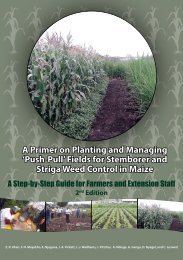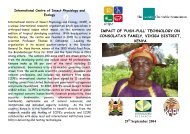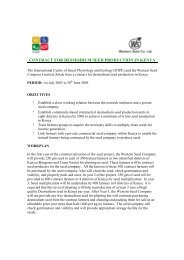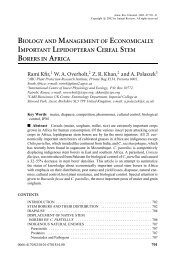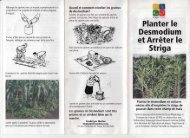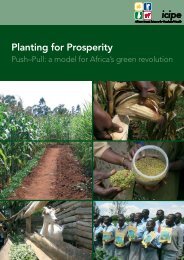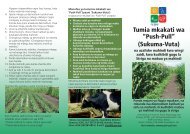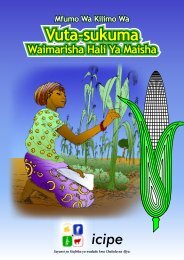The Royal Society Report - Push-Pull
The Royal Society Report - Push-Pull
The Royal Society Report - Push-Pull
Create successful ePaper yourself
Turn your PDF publications into a flip-book with our unique Google optimized e-Paper software.
Case study 3.2. <strong>The</strong> development of hybrid maize<br />
Hybrid vigour<br />
While testing his theory on the origin of species, Darwin compared inbred and cross-pollinated (hybrid) maize and<br />
found that the hybrids were taller than the inbred plants and were more tolerant of cooler growing conditions. This<br />
‘hybrid vigour’ (heterosis) was further studied by William Beal at Michigan State College, who observed increased grain<br />
yields in hybrids of different varieties.<br />
Single and double crosses<br />
In the early 1900s, experiments were conducted in which plants were self-pollinated for several generations to<br />
produce pure-breeding lines, which were then crossed to produce hybrids. <strong>The</strong> resulting high-yielding hybrids could<br />
be produced every year. <strong>The</strong>se hybrid seeds could easily be produced by removing the tassels from one block of<br />
inbred maize plants to allow pollination by an adjacent block of a second inbred line. This is more easily done on a<br />
large scale with maize than other cereal crops as maize is wind pollinated and the male and female flowers are on<br />
separate organs.<br />
However, as seed yields of the inbred parents were low with this method, the cost of hybrid seed was too high for<br />
farmers. When an additional, ‘double cross’ was performed (by crossing two of the single cross hybrids to produce the<br />
seed sold to farmers), yields were better than open pollinated varieties although not as good as the best single crosses.<br />
Seed production from ‘double crosses’ between high-yielding single cross hybrid parents became routine in the 1930s.<br />
Because of the doubling of yields, adoption of hybrid maize increased from 0 to 50% of Iowa’s corn acreage in just<br />
six years following its release in 1932.<br />
Commercial development<br />
Farmers could either grow hybrid maize by purchasing the single cross parent seed and performing the cross on their<br />
farm, or by purchasing ready to plant hybrid seed from farmer cooperatives or commercial seed companies. <strong>The</strong> latter<br />
emerged as the preferred choice.<br />
Although hybrid maize was first developed in the 1930s, the basis of hybrid vigour is still unknown. Further<br />
improvements in yield have largely resulted from improvements in the yield of the inbred lines. By the 1960s, the inbred<br />
lines were high yielding enough to use as seed parent and produce single cross hybrids for sale (which had a higher<br />
yield and were cheaper to produce than the best double crosses). Yields are now 4–5 times greater than those achieved<br />
with self-pollinated varieties in the 1920s. <strong>The</strong> aim of commercial seed companies is to increase yields again from about<br />
150 to 300 bushels per acre by 2030.<br />
Source: Duvick (2001).<br />
increased biomass production and light energy harvesting<br />
(Kebeish et al. 2007).<br />
Transfer of C4 metabolism into rice could achieve a yield<br />
increase of up to 50% (Hibberd et al. 2008), but the real<br />
gain could be a substantial increase in water use efficiency,<br />
a character normally associated with C4 plants.<br />
Engineering a bona fide C4 metabolism into a C3 plant may<br />
take at least 10 years but the metabolic shunt method<br />
could be achieved sooner.<br />
3.3.2 Abiotic stress<br />
Abiotic stress describes the impact of non-living factors<br />
such as drought, salinity, heat and toxic heavy metals.<br />
Genetic improvement and modified management of crops<br />
both have a role to play in dealing with abiotic stress.<br />
3.3.2.1 Crop management strategies to mitigate the<br />
effects of abiotic stress<br />
<strong>The</strong>re are diverse crop management strategies to mitigate<br />
the effects of abiotic stress. Some of these strategies have<br />
been derived empirically. <strong>The</strong> use of seed mixtures has<br />
been trialled to increase the robustness of yield against<br />
environmental stresses (see Case study 3.3). For example,<br />
genotypes of beans selected for high capacity to acquire<br />
phosphorus often have shallow roots (Lynch 2007). This<br />
can cause problems for crops in water-scarce<br />
environments, where deep roots can be advantageous for<br />
water scavenging. Mixtures of genotypes can be planted to<br />
buffer the crop yield against combinations of stresses. In<br />
such mixtures, it is possible that shallow rooted genotypes<br />
may also benefit from the extraction of water by deep<br />
rooters in the community (Caldwell & Richards 1989).<br />
Development of these techniques requires an<br />
understanding of the different crop ideotypes that are<br />
helpful to combat different environmental stresses.<br />
Turner (2004) has shown how wheat yields in Western<br />
Australia have increased by around 3-fold in 70 years, as<br />
rainfall has decreased. This has been achieved largely by<br />
changing the planting date of the crop to cover the ground<br />
while there is water available in the soil. This greatly<br />
reduces unproductive water loss via soil evaporation.<br />
Other options which would not require major scientific<br />
advances for their initial implementation, where<br />
26 I October 2009 I Reaping the Benefits <strong>The</strong> <strong>Royal</strong> <strong>Society</strong>



